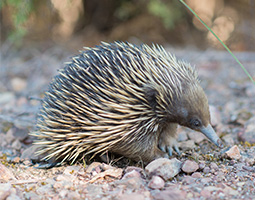Tachyglossus aculeatus
Description

The Short-beaked Echidna (Tachyglossus aculeatus) is ighout mainland Australia, Tasmania and the parts of Papua New Guinea. Growing from 30-45cm, Echidnas are mostly solitary animals only joining other Echidnas during the mating season from July to August. The Echidna is a monotreme (egg-laying mammal).
During the breeding season female Echidnas develop a pouch and lay a single leathery egg into it. The baby Echidna, called a puggle, hatches 10 days later, it is blind, and latches onto a milk patch where it stays for 8-12 weeks. After this time the baby is placed in a cool burrow (15 -18°C) where it is fed for two hours every five days until it is weaned at 7 months.
After leaving the burrow, Echidnas have been known to travel up to 40 km to find a new habitat and live up to 50 years.
Adaptations
- Maintain a lower body temperature than other mammals, at around 30 - 33°C
- Two layers of hair - short fur for keeping warm and longer hairs modified to form 50mm spines for protection
- Short beak can sense the electrical signals given off by insects
- Sticky tongue licks up prey and then grinds them up using bony plates in their mouth (no teeth)
Feeding relationships
- What I eat: ants, termites, grubs, larvae and worms
- What eats me: goannas, dingoes, foxes, feral cats, dogs, eagles and Tasmanian devils (which even eat the spines)
Interesting facts
Echidnas and platypus are the only surviving monotremes (egg-laying mammals). Echidnas can induce torpor (decreased physiological activity) as a response to trauma, stress or overheating where they can lower their body temperature to 4°C and heartrate to 4 beats per minute. Echidnas are good swimmers, paddling with only the snout and a few spines showing.